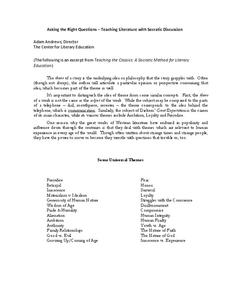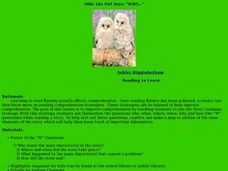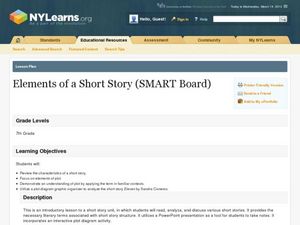Curated OER
Developing a Topic for Writing Using an Idea Web
Teach your upper graders how to use an idea web to develop a topic for writing. After reading a variety of stories about friendship (a list of stories with the theme of friendship is included), model using an idea web. Class members...
Curated OER
Comprehension: Identify Story Grammar
This fully scripted lesson could be a big help for someone new to teaching Kindergarten. It outlines what you should do and say as you teach grammar and literary elements such as, main character, setting, and events through reading. The...
Curated OER
Story Element Lesson Ideas Keeps Learning Interesting
There are some fun and interesting ways to make sure that students understand story elements.
Hawaiʻi State Department of Education
When We Are A Story
Drama and story elements go hand-in-hand. Have the class dive into a dramatic play to show character intention, conflict resolution, main events, and the dialogue in a Hawaiian folk tale. They read the story, then group-up to...
Curated OER
Picture This!
Students explore and generate story elements for wordless picture books. In this collaborative writing activity, students review wordless picture books and write a story based on the illustrations. Students use post-it notes to organize...
Curated OER
The Lorax Explorations
Middle schoolers read and debate the purpose of Dr. Seuss' The Lorax, analyze its story elements, and write their own The Lorax II.
Maine Content Literacy Project
Dramatic Structure of the Short Story
The second lesson in a series of fourteen, this plan takes the short story basics a step further. Learners complete a quiz about the story from the previous day, discuss the text, learn about Anton Chekhov, and work in groups to begin...
Curated OER
Recognizing Elements of a Short Story
In this short story elements learning exercise, students recognize the elements of short story by reading the sentences and selecting the correct story element. Students complete 10 online questions.
Curated OER
Five Elements of a Story
Here’s a graphic organizer that permits learners to chart the introduction, rising action, climax, falling action and resolution of a story. The PDF file can be customized to work with any narrataive.
Southern Nevada Regional Professional Development Program
Reading Literature - An Occurrence at Owl Creek Bridge
“An Occurrence at Owl Creek Bridge,” Ambrose Bierce’s short story, is used to model how structural moves, the decisions an author makes about setting, point of view, time order, etc., can be examined to reveal an author’s purpose. Groups...
Core Knowledge Foundation
Second Grade Skills Unit 2: Bedtime Tales
A unit covering second-grade skills reviews 16 letter-sound correspondences, tricky words, and punctuation. Readers provide context for examining story elements, and pupils participate in close reading and write narratives retelling a...
Writing Educators Symposium
Asking the Right Questions
It can be difficult to find the theme of a book or story if you don't know the questions to ask. Teach your kids to discern the universal theme in works of literature with a set of activities that promote critical thinking and...
IPDAE
Themes in Short Stories
"What is the theme of this story?" The very question can spark fear in the minds of readers and incinerate confidence. Here you will discover an exercise that shows how writers use the tools of setting, plot, conflict, and...
Curated OER
Book Discussions in a Reading Partnership
Do you have a lot of different reading levels in your class? Pair kids up by level and have them choose a book to read independently. They will make predictions, ask questions, make connections, etc. Consider creating a general reading...
Curated OER
Plot Structure PowerPoint Presentation
A plot diagram helps readers visualize the structure of a story. Here’s a presentation that expands upon the traditional diagram and examines plot components (exposition, rising action, climax, falling action, resolution) as well as...
Curated OER
Ollie the Own Says: WHO
Scholars examine the strategy of making a story map or outline to identify the main elements of a story. They discuss the who, what, where, when, why, and how of a story, in an outline form. As a class they read a short story, answer the...
Curated OER
Build a Tasty Sandwich
The subject doesn't sound to interesting, but with a child's imagination even a trip to the store can be an adventure. The class writes a narrative story about a trip to the store. They organize their stories to include an introductory...
Curated OER
Convergence with The Cay: Exploring Geographic Concepts Wrapped in a Story
Here's an awesome unit that uses The Cay as the anchor text. The 16-page packet is loaded with teaching ideas, activities, and suggested adjustments.
Curated OER
Elements of a Short Story (SMARTboard)
TV for homework? Your pupils' dreams have come true! After reading Sandra Cisneros's "Eleven," they analyze the elements of the story, particularly the plot and and climax. The activity could work with any short story that you are using...
Curated OER
Literary Elements Worksheets and Graphic Organizers
Using graphic organizers can be an effective way to teach literary elements.
Curated OER
Snow Globe Family
Kindergartners sequence the parts of a story using a snow globe as a setting. They will listen to Snow Globe Family and retell the parts of the story noting the beginning, the middle, and the end. Then they will make their own snow...
Curated OER
Collective Poetry: Teaching Tolerance
Help your class create collective poetry following a simple, engaging model from Teaching Tolerance (tolerance.org). Each young poet writes five things on an index card: sayings from others, favorite sound, favorite place, favorite...
Curated OER
Come Fly with Me . . . Open a Book: Travels through Literature
This detailed overview of a curriculum unit suggests using travel literature to engage and stimulate your third graders’ interest in reading. The suggested reading list includes fiction and non-fiction materials and offers urban children...
Curated OER
Same Theme, Different Story Using Fox by Margaret Wild
Middle schoolers work with themes in this lesson, which is based on Fox by Margaret Wild. Because the book has multiple themes, it is a great way to transition into exploring literary analysis and writing stories. A Six Trait writing...

























